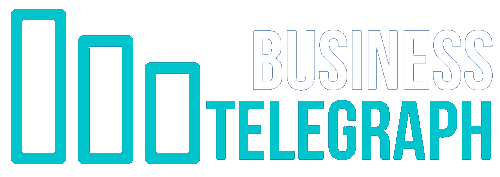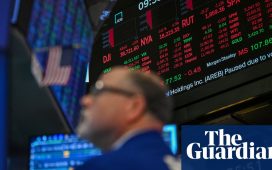Key events

Kalyeena Makortoff
Extinction Rebellion protesters have camped outside of the NatWest AGM this morning, amid concerns over amendments to the bank’s policy around fossil fuels, which they claim has opened the door to further financing of oil and gas.
Extinction Rebellion is, this morning, particularly concerned about NatWest’s ongoing support for fossil fuel company BP, chanting:
NatWest, do your best
From BP divest, divest
Kelly Shields, a senior campaign manager at ShareAction said there appear to be some “loopholes” that have allowed NatWest to keep financing BP – including that the bank is assessing BP on 2021 climate policies and footprints.
BP has recently rowed back on its green commitments in a move that sparked a shareholder rebellion last week.
NatWest said in a statement that its total exposure to the oil and gas sector amounted to 0.5% of its financing activity. A spokesperson said:
The UK’s energy transition is dependent on many evolving factors – be that policy, technology or societal response – and we confirmed in our sustainability report earlier this year that we would review our climate targets during 2025, ensuring our policies and frameworks are aligned to the UK’s broader transition outlook.We will continue to be transparent on our policy and risk criteria in this area and will publish these once the review is completed.

Kalyeena Makortoff
In Edinburgh, NatWest Group’s annual general meeting (AGM) started at 10am.
Shareholders arived at the conference centre at NatWest’s sprawling Gogarburn campus in a cloudy Edinburgh this morning for a historic AGM, reports our banking correspondent Kalyeena Makortoff from Scotland.
This is the final shareholder meeting before the bank, formerly known as Royal Bank of Scotland, fully returns to private hands, nearly 17 years after its £46bn bailout at the height of the 2008 financial crisis. The government, which once owned 84% of the lender, is due to sell off its remaining 2.99% stake in the coming weeks.
And so much has changed.
Prior to its bailout, RBS was the largest bank in the world. But having slimmed down and sold off its raft of international businesses in the wake of the government rescue, it is not even the largest in the UK: trailing behind HSBC, Barclays and Lloyds in terms of assets.
And while executives are due to address shareholders this morning from the £350m Gogarburn campus that came to symbolise the excesses of its disgraced former boss Fred Goodwin, the message will be quite different than his predecessor.
Under chief executive Paul Thwaite, it’s now a message of moderation, careful assessment of risk, and assurances that the bank is much safer than the one that sparked a recession and left Edinburgh’s financial sector in tatters in 2008.
But whether shareholders expect the bank to take bigger risks once the privatisation is complete, remains to be seen.
Carsten Brzeski, global head of macro at ING, said:
The April PMIs [for the eurozone] did not bring the anticipated reaction after three weeks of tariff tensions and uncertainty. In fact, not all puzzle pieces match. While the broader weakening in sentiment in France and Germany is in line with expectations, the fact that the eurozone as a whole saw sentiment in the manufacturing sector even slightly improving is somewhat odd.
As so often is the case, it looks as if traditional survey-based data is reacting with some delay to big events. We wouldn’t be surprised to see a more significant drop in manufacturing PMIs next month. In any case, previous eurozone optimism is crumbling and fears of disinflation and stagnation have returned.
The only good thing about the current situation is that it is mainly man-made and could be easily reversed. However, until it is, it will again be up to the European Central Bank to do the heavy lifting in the eurozone. The announced and intended fiscal stimulus in Germany, as well as European efforts to increase defence spending, will take time to substantially boost economic activity in the eurozone.
Eurozone economy ‘broadly stable’ in April
By contrast, the eurozone’s private sector output was broadly stable in April, according to a sister survey.
Business activity was held back by a faster reduction in new orders and waning confidence – business sentiment was the lowest for almost two-and-a-half years.
Manufacturers continued to scale back purchasing, and overall inflationary pressures eased, with both input costs and output prices rising at weaker rates.
The flash Eurozone PMI output index from Hamburg Commercial Bank, compiled by S&P Global, posted 50.1 in April, only slightly above the 50.0 no-change mark that divides expansion from contraction. The latest reading was down from 50.9 in March and the lowest in four months.
In the services sector, business activity fell slightly, ending a four-month run of growth. Manufacturing production rose for the second consecutive month, and at the fastest rate since May 2022.
In Germany, Europe’s largest economy, business activity fell for the first time in four months during April after growth hit a ten-month high in March. Meanwhile, France remained in contraction and the pace of decline in business activity accelerated.
The rest of the eurozone continued to record solid growth of output, albeit with the pace of expansion easing slightly from that seen in March.
Companies were reluctant to raise output given a further reduction in new orders during April, the eleventh in as many months. Moreover, the latest decline in new business was the most marked so far this year, across both the manufacturing and services sectors.
New export orders (which include exports within the eurozone bloc) also declined. New export orders have been falling since March 2022. April saw a sharp drop in business confidence in the euro area, with sentiment the lowest since November 2022.
On top of the tariff chaos since Donald Trump’s ‘Liberation Day’ on 2 April, the rises in business costs announced in last October’s budget came into effect in April – resulting in a pretty “awful April” for many businesses in the UK.
Alex Kerr, UK economist at Capital Economics, said:
The marked fall in the composite PMI in April raises the chances that the uncertainty stemming from the US tariffs chaos will be a bigger drag on the UK economy than we expect. That said, we doubt that GDP growth at the start of Q2 will be as weak as the 0.5% 3m/3m fall the PMI suggests…
Overall, although Trump’s tariffs may prove to be disinflationary for the UK eventually, the continued stickiness of near-term price pressures suggests that the Bank of England will continue to cut interest rates gradually from 4.50% now to 3.50% in the first half of next year.
The collapse in confidence and drop in output during April raise red flags for the economic outlook and add pressure on the Bank of England to reduce interest rates again at its May meeting, said Chris Williamson, chief business economist at S&P Global Market Intelligence.
While recent months have been characterised by UK businesses treading water, broadly stagnating since last autumn’s budget, businesses are reporting more of a struggle to keep their heads above water in April.
April’s fall in output was the largest recorded for nearly two and a half years, consistent with GDP declining at a quarterly rate of 0.3%, reflecting falling activity and demand across both manufacturing and services.
Job cutting remains aggressive as business optimism about the year ahead sank to a two-and-a-half-year low, and one of the lowest levels yet recorded by the survey, even surpassing the low seen in the immediate aftermath of the Brexit vote in 2016.
The disappointing survey reflects the impact of headwinds from both home and abroad. The biggest concern lies in a slump in exports amid weakened global demand and rising global trade worries, but higher staffing costs have also piled pressure on companies – linked to the National Insurance and minimum wage changes that came into effect at the start of the month. Just as export orders are falling at the sharpest rate since May 2020, during the pandemic lockdowns, firms’ costs spiked higher to a degree not seen for over two years.
Slump in export orders pushes UK private sector into decline
The UK’s private sector went into decline for the first time in 1 1/2 years, as new export orders fell at the fastest rate in almost five years, in a sign that trade wars are taking their toll on the British economy.
Weaker demand from international markets weighed on business activity in both the manufacturing and service sectors, according to a closely watched survey.
At 48.2 in April, down from 51.5 in March, the headline ‘flash’ reading from S&P Global was below the 50 mark (that separates expansion from contraction) for the first time since October 2023. While signalling only a modest rate of decline, the latest reading was the lowest since November 2022.
Firms talked about the negative impact of US tariffs and a subsequent slump in confidence among clients. Optimism about the year ahead also slumped, to its lowest level since October 2022.
Many companies flagged concerns about worsening global economic prospects in the wake of US tariffs, as well as subdued confidence regarding the outlook for domestic business conditions.
Service providers recorded a slight decline in business activity during April, which ended a 17-month period of expansion. Rising global economic uncertainty and subdued domestic demand conditions were cited as the main factors.
Manufacturers recorded a fall in production volumes for the sixth successive month. The latest decline was the steepest since August 2022 and widely attributed to weakening market conditions, especially in key export markets.
Peel Hunt’s chief economist Kallum Pickering said:
The eurozone’s second-largest economy, France, remained under pressure this month, according to the latest PMI survey, as private sector output declined for an eighth month in a row.
Business activity was dragged down by a sharp reduction in new orders, with survey data implying pronounced demand weakness within domestic markets. Firms’ expectations for output over the next 12 months were pessimistic and their most downbeat in close to five years.
The headline HCOB Flash France Composite PMI Output Index fell to 47.3 in April, down from 48.0 in March, signalling a moderate but sharper contraction in private sector business activity at the start of the second quarter.
April’s contraction was entirely driven by the service sector, while manufacturing production increased for the first time since May 2022.
Weakness was mainly from within France. While total new orders shrank at a markedly quicker pace in April, new export sales saw its shallowest drop since August 2022. Africa and some areas of Europe were cited as sources of growth.
Rachel Reeves is between a rock and a hard place as the tariff turmoil takes its toll, said Susannah Streeter, head of money and markets, Hargreaves Lansdown.
Fresh from the disappointing analysis from the International Monetary Fund which noted a sharp growth slowdown for the UK this year, the latest public sector borrowing costs make difficult reading for the UK government. It was forced to go into the red more than forecast for the year to the end of March.
With growth this year expected to slow to 1.1% according to the IMF, down from 1.6%, tax receipts will also be lower. Rachel Reeves is between a rock and a hard place, as the tariff turmoil takes its toll, and some businesses become more cautious about investing following the rise to payroll costs introduced in the Budget. While Reeves keeps deflecting rumours about tax rises, something will have to give, to enable to her to meet her fiscal rules.
Brent Crude has made further gains, with the benchmark pushing above $68 a barrel amid the improving sentiment with hopes that lower tariffs will be less onerous on the global economy.
Fresh US sanctions on an Iranian energy tycoon Seyed Asadoollah Emamjomeh has led to expectations that there could be a further curb on Iranian exports. Traders are awaiting official US data on crude stockpiles with industry figures indicating a sharp fall in inventories, indicating demand has been higher than expected.
Here’s our full story on the rise in UK government borrowing, which means the chancellor could be forced to raise taxes or announce deeper spending cuts later this year.
Britain entered the economic shock from Donald Trump’s trade wars with government borrowing having overshot official forecasts by almost £15bn in the most recent financial year.
Adding to the pressure on the chancellor, Rachel Reeves, the Office for National Statistics said borrowing in the financial year ending in March was £151.9bn, more than £20bn higher than in the previous financial year.
After a larger than anticipated rise in borrowing in March, the figure was £14.6bn more than the Office for Budget Responsibility (OBR) had predicted less than a month ago in forecasts published alongside the chancellor’s spring statement.
In a setback for the government, economists warned that Reeves could be forced to increase taxes or announce deeper cuts to public spending at the autumn budget if she wanted to maintain her self-imposed fiscal rules.
Germany’s private sector moved back into contraction in April, as tariff worries and general uncertainty weighed on business confidence and demand, according to a closely-watched survey.
The latest ‘flash’ purchasing managers index from Hamburg Commercial Bank showed firms’ growth expectations sank to their lowest in six months and the labour market remained under pressure, although employment fell only slightly and at the slowest pace in almost a year.
The headline index fell below the 50.0 mark that separates expansion from contraction for the first time in four months in April. However, at 49.7, down from 51.3 in March, it signalled only a marginal rate of contraction.
The renewed downturn was driven by the service sector, which saw business activity fall for the first time since last November and at the quickest rate since February 2024, with that index at 48.8. Manufacturing production rose for the second month running, although the rate of growth was only modest and eased since March, with the index at 51.6.
The latest data also showed the first rise in prices charged by manufacturers in almost two years, while their input prices posted a sharp drop, contrasting with still-strong cost inflation in the service sector.
US will aim for UK to cut car tariff to 2.5% from 10%
As the US is gearing up for trade negotiations with the UK, it will push for London to reduce its automotive tariff from 10% to 2.5%, the Wall Street Journal reports, citing people with knowledge of a draft document circulated by Donald Trump’s administration.
Rachel Reeves, the chancellor, is due to meet Treasury Secretary Scott Bessent this week to push Britain’s case for a trade deal with Washington.
Washington is preparing its terms for the negotiations, and wants London to reduce levies and other non-tariff barriers on a variety of goods, the report said, adding the Trump administration also wants more relaxed rules on US agricultural imports, including beef.
Trump imposed a 10% tariff on most imports from Britain and a 25% tariff on key sectors such as cars and steel.
It is unclear if the US would consider reducing its 10% tariff on the UK if London agrees to all of its trade demands, according to the Journal. Trump has previously said the 10% tariff is a “floor” for all nations, but also indicated there could be exceptions.
White House spokesman Kush Desai said:
The administration’s trade and economic team is working at breakneck speed to negotiate custom-tailored deals with our major trading partners. Any final decisions and agreements, however, will come from President Trump and President Trump only.
European stocks have also opened higher, as a wave of relief spread across markets.
The UK’s FTSE 100 index is up by 1.2% at 8,430, while the Italian FTSE MiB rose by 1.4%. Germany’s Dax jumped by 2.2% and France’s CAC gained 1.6%.
Gold, which surged through $3,500 an ounce yesterday, a new record high, is down by more than 2% at $3,307 an ounce, as demand for the safe-haven asset receded.
ING currency analyst Francesco Pesole explained:
Bessent threw a lifeline to fragile US sentiment with conciliatory remarks on the US-China trade war. Bessent said the current tariff situation is “unsustainable” and expects a de-escalation in the near term.
We could witness a period where the dollar is tossed around by headlines of Fed independence risk and market-friendly news on US tariff policy. What is clear by now is that no other G10 currency has a higher positive beta to trade news than the dollar.
Net-net, we still think the balance of risks remains skewed to the downside for the dollar in the near term, but we don’t expect a repetition of the one-way traffic in dollar selling we have witnessed of late. Looking a few weeks ahead, our preference is for a stabilisation in the dollar rather than another structural weakening.
Introduction: UK annual borrowing nearly £15bn above official forecast; stocks rise as Trump rows back on Fed attack
Good morning, and welcome to our rolling coverage of business, the financial markets, and the world economy.
Government borrowing in the UK rose more than expected last month, which means the government borrowed nearly £15bn more than forecast over the year than in the previous fiscal year, underlining the challenges the chancellor Rachel Reeves faces.
Borrowing – the difference between total public sector spending and income – was £16.4bn in March; this was £2.8bn higher than in March 2024, and the third-highest March borrowing since monthly records began in 1993.
This means the government borrowed £151.9bn in the fiscal year to March – £20.7bn more than in the previous year, and £14.6bn more than the £137.3bn forecast by the Office for Budget Responsibility (OBR), the arbiter of the public finances.
Public sector net borrowing excluding public sector banks was £151.9 billion (or 5.3% of GDP) in the 2024 to 2025 financial year,
£20.7 billion (or 0.5 percentage points) more than in the previous year and the third highest total on record.
Read more ➡️ https://t.co/OKGJdDm02v pic.twitter.com/obTVjjOX9x
— Office for National Statistics (ONS) (@ONS) April 23, 2025
Nabil Taleb, economist at PwC UK, said:
Debt interest payments reached £4.3bn in March, the highest March figure since monthly records began 27 years ago. This reflects the fiscal challenge the chancellor faces. Higher debt servicing costs as a share of total revenues will leave the public finances more exposed to future economic shocks.
Rachel Reeves continues to hold the fiscal line, but the next six months will be critical—and she needs some clear wins. While her spring statement restored the £9.9bn headroom, that cushion remains precarious. In the worst-case scenario outlined by the government’s independent forecaster, Trump’s new tariffs could alone shave 1% off UK GDP—enough to wipe out the headroom entirely. The rising cost of government borrowing and growing global uncertainty are compounding the pressure for Reeves to put tax rises on the table during the autumn budget.
Stocks and the dollar bounced back and oil prices rose, as Donald Trump rowed back on his attacks on America’s top central banker, whom he called a “major loser” on Monday for now cutting interest rates.
The US president said he had no plans to fire Federal Reserve chair Jerome Powell, and hints at lower tariffs for China, also from the US treasury secretary, cheered investors. Scott Bessent said the current tariff situation is “unsustainable” and expects a de-escalation in the near term.
Trump said during a White House news conference that high tariffs on goods from China will “come down substantially, but it won’t be zero”.
On Wall Street yesterday, Dow Jones Industrial Average, which tracks 30 large US companies, the broader S&P 500 and the Nasdaq all ended the day up more than 2.5% following Monday’s sell-off.
In Asia, Japan’s Nikkei rose by nearly 2% and Hong Kong’s Hang Seng was up 2.2% and the South Korean Kospi gained 1.6%.
The dollar, which hit a three-year low yesterday before recovering, rose by 0.25% against a basket of major currencies.
ING currency analyst Francesco Pesole said:
The dollar is enjoying some support thanks to a recovery in US market sentiment. At the moment, no other G10 currency has a higher beta than the dollar to US trade news, and Treasury Secretary Scott Bessent’s seemingly conciliatory comments on a US-China trade de-escalation could favour a dollar stabilisation.
In oil markets, Brent crude is 1.3% ahead at $68.32 a barrel while US crude rose by 1.37% to $64.55 a barrel. Signs of de-escalation are positive for the world economy, which would boost demand for crude.
The Agenda
-
9am BST: Eurozone HCOB PMI surveys flash for April
-
9.30am BST: S&P Global PMIs flash for April
10am BST: Eurozone trade for February -
2.45pm BST:: US S&P Global PMIs flash for April
-
5.30pm BST: Bank of England governor Andrew Bailey speaks










